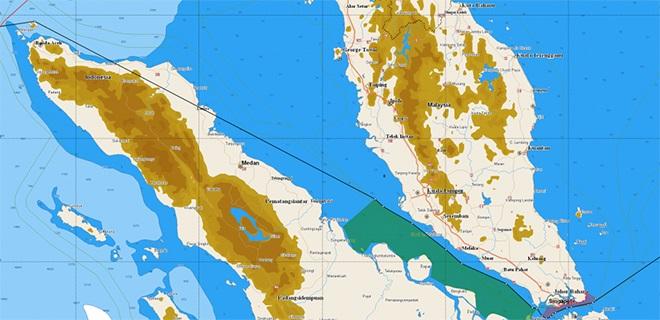Volvo Ocean Race Leg 3 - The big casino
by Gonzalo Infante on 19 Jan 2015

Course geometry of Malacca Strait. Volvo Ocean Race
http://www.volvooceanrace.com
Volvo Ocean Race Leg 3 - The Malacca and Singapore Straits are a big talking point of this leg - and not without reason. These narrow and busy passages have all the ingredients to make them extremely difficult places to race sail boats.
If we look at the big picture, we can see that is the only piece of water that connects the north Pacific and north Indian Oceans - and this has some interesting implications, not only related to the ocean and weather but also human activities.
For instance, here are some facts to consider:
• This is a tropical area, close to the Equator with big Intertropical Convergence Zone influence.
• A narrow passage between the Malaysian Peninsula and the island of Sumatra.
• The current is generally set to NW. Close to the shore the tide will change the intensity of the current but in the middle it's fairly consistent.
• Both land masses are flat at the extremes and with big mountains in the middle.
• In the north, the weather is dominated by Gulf of Thailand - in the south by the South China Sea, and in the middle land/sea interaction drives the wind.
• Squall lines, thunderstorms and waterspouts are very frequent.
The course
Right after crossing the north western tip of Sumatra and leaving Pulau Weh island to starboard, the Malacca Strait begins. Its width is relatively high at the beginning, decreasing gradually as you head south east. As it becomes more narrow, a Traffic Separation Zone is put into place so the thousands of merchant vessels that transit the area can do so in an organized way and out of trouble.
The race organizers put in place exclusion areas (the red and green areas in the picture) to keep the fleet away from the worst of traffic density, but this does have a downside: it's quite restrictive in terms of the width of the race course. In the Malacca area, the sailable part ranges from 1 to 4nm and it is restricted to lie between the north east side of the TSS and south west coast of the Malaysian Peninsula. The waters are very shallow and not free of wreck obstructions and sand banks. Fishing activity can also be an issue.
In the Singapore channel, the exclusion zone is set so that the fleet sails away from the Singapore harbour and close to Batam Island.
[Sorry, this content could not be displayed]
Weather
At this time of the year, with the winter monsoon in good health, the prevailing wind in the South China Sea is north east. When it meets the high grounds of Malaysia, it splits in two directions: veered in the north, over the Gulf of Thailand to a more easterly direction and backed in the south, close to Singapore, to north-north east. That's why in the north part of Malacca the winds come from the east, while in the south they come from the north.
But what makes it really difficult is the middle section. As we can see in the figure, the NE monsoon cannot get trough the land mass, and the wind is driven by local land sea interactions, together with thunderstorm formation.
The story goes as follows: as the two coastlines are facing one another, land breezes will converge (land to sea) and sea breezes diverge (sea to land). The convergence is the necessary ingredient to make air rise and create energic squall lines. These will grow overnight and in some cases generate prominent electrical activity.
You don’t want to get caught in this area as the wind will rise up and not move horizontally. Divergent sea breezes will generate windless areas that will sometimes be difficult to avoid. Finding the converging and diverging points will be critical, as proper positioning is necessary in order to not get caught in windless areas.
On the oceanographic side, we can say that the current is generally set to north west, but tide variations become more important close to shore and in the narrow part of the strait.
Strategy
I know what you're thinking. 'Strategy? Really? In these random conditions?'
Well, I see your point - but it's not a joke. There are some things that we know, and can be used to better navigate this area.
Of course, there is only one part of the Strait where the fleet will have the freedom to choose different options, and once they arrive in the narrow part, there'll be no room for general strategy - luck will be the main factor.
Here's what we know:
• The monsoon veers easterly and fills in nicely before being blocked by Malaysia orography. Using it for as much time as possible is key.
• Close to the Sumatra coastline, the breeze will get unstable. Don’t get close unless you have no other option than to use local breezes.
• Current is set to north west, from one to three kts, but isn't homogeneous across the course. We need to avoid the worst of it.
• Direct course lies close to Sumatra. Going too close to Malaysia at an early stage will add many miles.
• Squalls will make a big impact on the course. Following the evolution of these with radar will be key for proper positioning.
• After getting into the TSS area, the only factors to play with will be shallow waters, squalls, current and traffic... lots of traffic. Certainly, bad traffic management could make you lose many miles.
If you want to link to this article then please use this URL: www.sail-world.com/130842